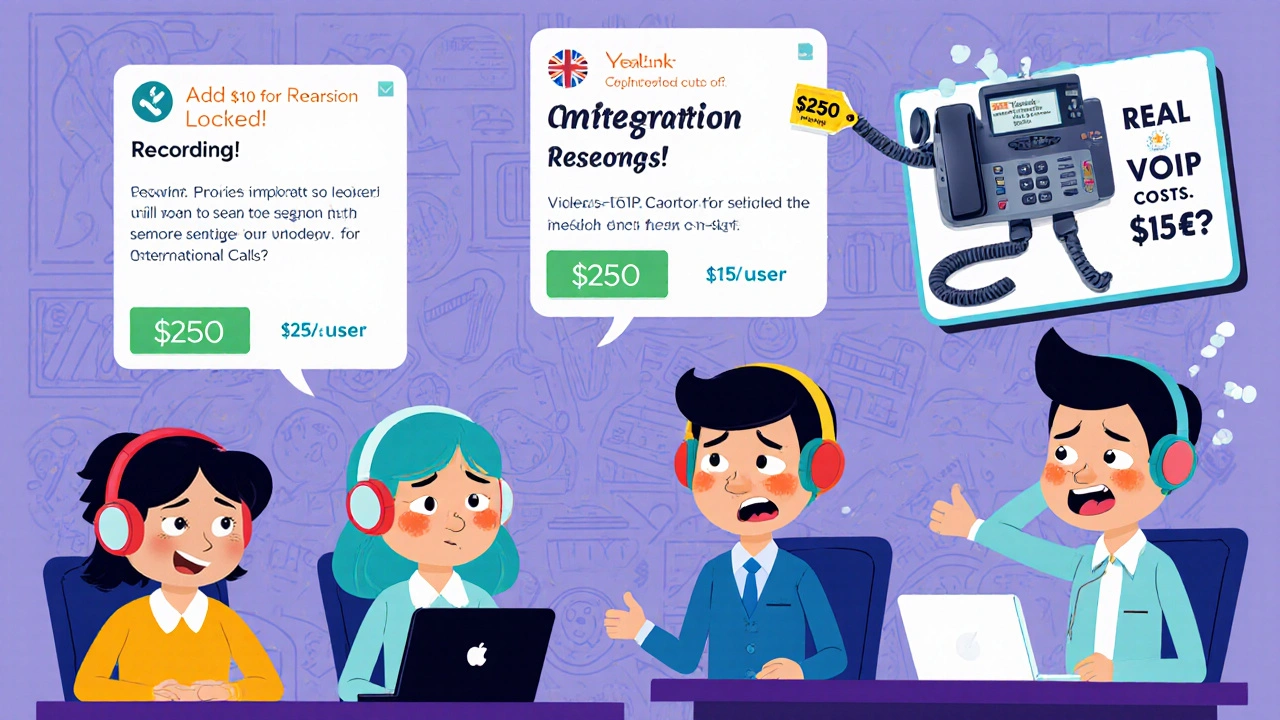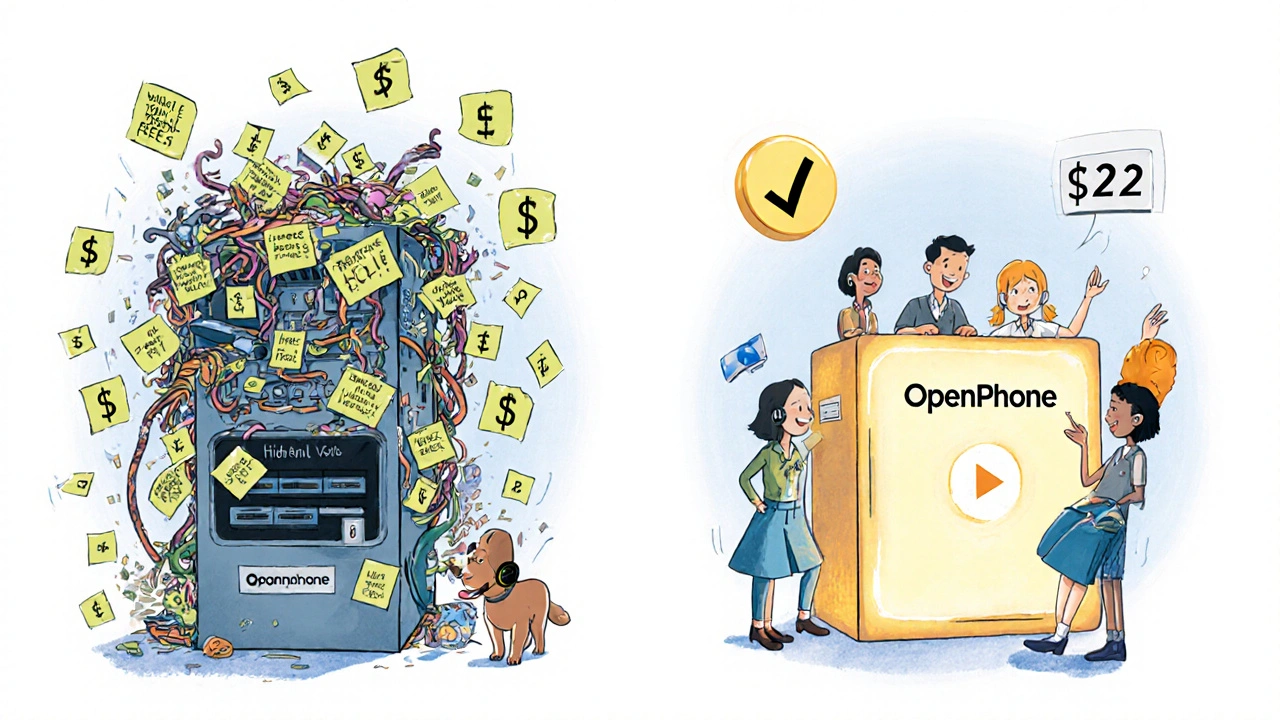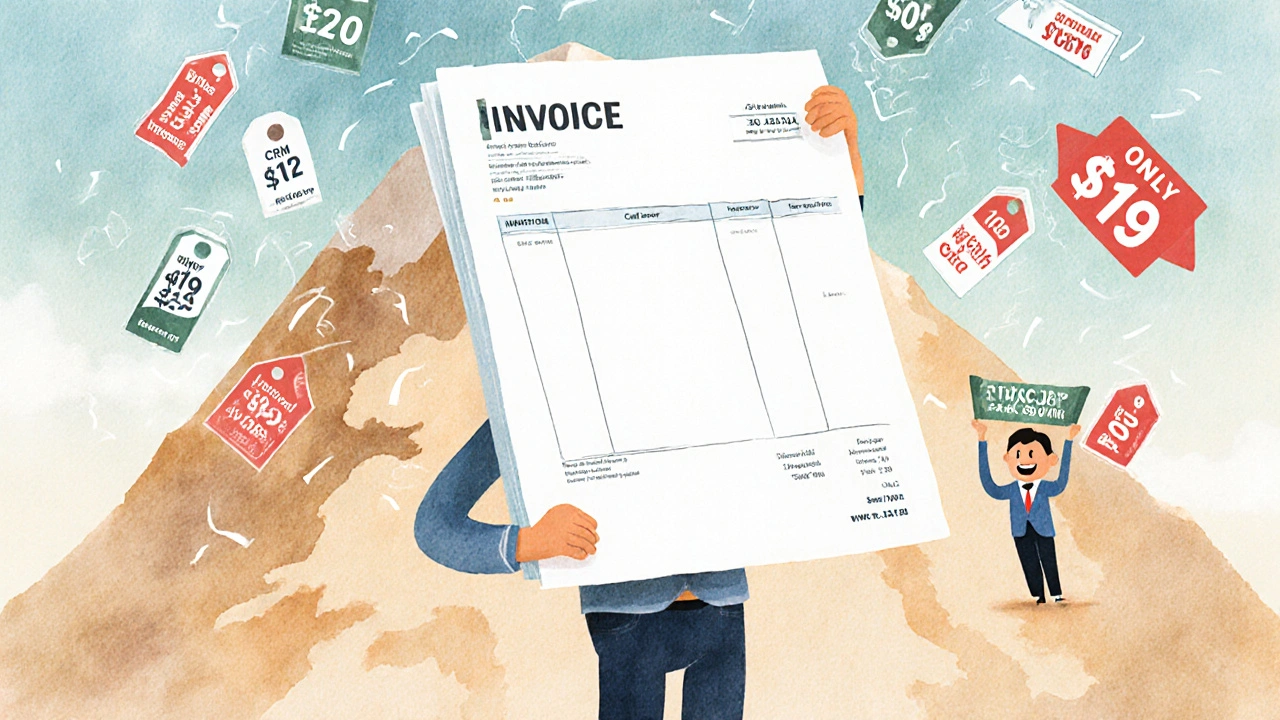You signed up for VoIP because it was supposed to save you money. The ad said $19 per user. You thought you were getting a modern, flexible phone system for less than your old landline bill. But then the invoice came. Suddenly, you’re paying $42 per user. What happened?
That $19 Plan Isn’t What You Think
Most VoIP providers advertise base prices between $10 and $30 per user. Sounds great-until you realize those prices are for the bare minimum. Basic calling. Maybe voicemail. No call recording. No CRM integration. No auto-attendant beyond two options. If you’re a small business with five employees, that $19 plan might work-if you never need to do anything beyond answering calls. But real businesses need more. You need to record calls for compliance. You need your phone system to talk to your CRM. You need an auto-attendant that doesn’t sound like a robot from 1998. And that’s where the fees pile up. Here’s the truth: hidden VoIP fees aren’t rare. They’re the norm. Gartner found that 78% of businesses underestimate their final VoIP costs by 25-40%. That’s not a mistake. That’s how the model works.The Big Four Hidden Costs You Can’t Ignore
There are four categories of add-ons that most businesses run into-and they’re rarely mentioned in the sales pitch.- Call recording and compliance: Basic plans often include no recording at all. If you’re in healthcare, finance, or even legal services, you need it. RingCentral charges $20 per user per month for advanced recording. Zoom adds $10 per user if you want recordings stored longer than 30 days. For HIPAA or FINRA compliance, expect to pay 45-110% more than the base price. One healthcare client in Exeter paid $38 per user-not $19-just to meet legal recording rules.
- CRM integrations: If you use Salesforce, HubSpot, or Microsoft Dynamics, connecting your phone system isn’t free. Zoom charges $12 per user monthly for Salesforce CPQ integration. ServiceNow? $18 per user. Even basic contact syncing with Google Contacts can cost $10 per user on some platforms. These aren’t optional for sales teams-they’re essential.
- International calling: Domestic calls are usually included. But call Canada? $0.008 per minute. India? $0.35 per minute. The UK? $0.02. Most providers don’t tell you this until you try to dial abroad. One company in Devon added five international sales reps and saw their monthly bill jump $700 overnight because they didn’t realize international minutes weren’t bundled.
- Hardware: You think your laptop mic and headphones are enough? Maybe for a quick call. But for daily business use, you need proper IP phones. A basic Poly VVX 150 costs $80. A Yealink T54W with a color screen? $250. Conference systems like Cisco Webex Room Kit? $5,000. And if you’re upgrading your network for Quality of Service (QoS)? That’s another $500-$2,000. Most businesses forget to budget for this until their calls drop mid-sentence.
One-Time Fees That Sneak Up On You
It’s not just monthly charges. There are upfront costs that catch people off guard.- Number porting: Moving your existing business number to VoIP? Most providers charge $39.99 per number. Some charge more. That’s $200 just to move four lines.
- Setup fees: Expect $100-$500 for configuration, user onboarding, and system testing. Some providers hide this in the fine print.
- Training: Your team won’t magically know how to use the system. Basic training takes 2-3 hours per person. For complex systems, it’s 8-12 hours. Hiring an external trainer? $500-$1,500.
- Professional services: Custom integrations with your ERP or billing software? $3,000-$5,000. Zoom’s own partner docs say Salesforce integration averages $1,200 in professional fees.
One IT manager in Bristol told me his team budgeted $10,000 for a 15-user VoIP system. The final cost? $17,500. Half of that was unplanned one-time fees.

Scaling Up? Watch Out for Price Jumps
Many providers use tiered pricing. You start at $15 per user for 1-10 users. But add the 11th user? The price jumps to $28 per user across the board. That’s not a discount for volume. That’s a penalty for growth.Steve Leaden from Omdia calls this “budget shock pricing.” Companies think they’re saving money by starting small. Then they hire more staff, and suddenly their monthly bill doubles-not because they added features, but because they crossed a user threshold.
FreJun and OpenPhone are two exceptions. They bundle recording, CRM sync, auto-attendant, and international calling into one flat rate: $17-$22 per user. No surprises. No upsells. They’re growing fast because businesses are tired of the game.
Why Do Providers Do This?
It’s not just greed. It’s business strategy.VoIP is a commodity now. The core technology is cheap. So providers compete on price-but only for the base package. Once you’re locked in, they make money on the add-ons. That’s called “feature unbundling.” Gartner says 87% of providers now separate calling from analytics, recording, and integrations. Why? Because people will pay for each piece individually. It’s more profitable than offering a full package.
Some providers even hide fees in regulatory charges. The FCC’s Universal Service Fund fee is rising to 3.2% in Q3 2025. That’s passed on to you. Some providers list it as a separate line item. Others just roll it into the monthly fee. Either way, you’re paying.

How to Avoid Getting Screwed
You don’t have to be another statistic. Here’s how to protect yourself:- Ask for a full cost breakdown: Don’t just ask for the base price. Ask: “What’s included? What’s extra? Show me every possible add-on.”
- Calculate your real usage: How many international calls do you make? Do you need call recording? How many users will need CRM access? Build your own cost model.
- Check the contract: Look for early termination fees. One company paid $10,800 to cancel a 36-month contract early. That’s $600 per line. Never sign without knowing the exit cost.
- Test the system: Ask for a trial. Use it like you would in real life. Make international calls. Record a call. Try to sync with your CRM. If it’s clunky or requires extra fees, walk away.
- Go all-in if you can: Providers like OpenPhone, FreJun, and Dialpad offer transparent, all-inclusive pricing. They cost a bit more upfront-but you’ll save hundreds per month in hidden fees.
The Bottom Line
VoIP saves money. No doubt about it. But only if you know what you’re really paying for.That $19 plan? It’s a trap if you need anything beyond basic calling. The real cost of VoIP isn’t in the headline number. It’s in the fine print. The add-ons. The one-time fees. The hidden upgrades.
Businesses that do their homework save 30-50% over the long term. Those who don’t? They end up paying more than they did on landlines-and with worse service.
Don’t choose VoIP because it’s cheap. Choose it because it’s honest. And if a provider won’t tell you the full cost upfront? Find one that will.
Are VoIP hidden fees legal?
Yes, as long as they’re disclosed in the contract. The FCC’s 2025 VoIP Transparency Initiative requires providers to list all potential fees upfront, but enforcement is inconsistent. Many still bury fees in fine print. Always read the full terms. If something isn’t clearly listed, ask for it in writing before signing.
Which VoIP providers have the least hidden fees?
OpenPhone and FreJun lead in transparency. Both offer flat-rate pricing that includes call recording, CRM sync, auto-attendant, and international calling. RingCentral and Zoom have more add-ons but offer better enterprise features. Vonage and 8x8 tend to have more hidden charges, especially for international calls and CRM integrations. Check G2 reviews for ‘pricing transparency’ ratings-OpenPhone scores 4.7/5, Vonage 2.4/5.
How much should I budget for a 10-user VoIP system?
Don’t just multiply the base price by 10. Here’s a realistic estimate: Base plan at $22/user = $220. Add call recording: $10/user = $100. Add CRM integration: $12/user = $120. Add two international calling plans: $40. Number porting: $40. One-time setup: $200. Training: $800. Total: $1,520/month. That’s $152 per user-not $22. Always build your budget around real needs, not advertised prices.
Can I avoid hardware costs entirely?
You can, but you shouldn’t. Using a laptop mic and headphones works for occasional calls, but not for daily business use. Call quality drops, background noise becomes a problem, and your team gets frustrated. Budget at least $100 per user for a decent IP phone. For managers and sales teams, $250 phones are worth it. The savings on productivity and customer perception far outweigh the hardware cost.
What’s the biggest mistake businesses make with VoIP pricing?
They assume the base price is the total cost. Most businesses start with the lowest plan, then add features one by one without realizing how quickly the fees compound. One company in Exeter thought they were saving money with a $19/user plan-until they added recording, CRM sync, international calling, and ported five numbers. Their final cost: $44/user. They paid $1,500 more than they expected in the first month alone.
